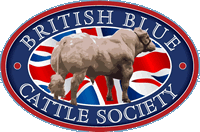The Importance of Questioning Yourself and Others
From a standing start in 1987 with 12 Hereford cross dairy cows, Mike Powley and father Tom have built their 100 head suckler herd on the principals of having a system which is easy to work with and produces the quality and type of finishing animal which suits the current market, writes Fiona Sloan. Tom and Mike Powley will be familiar to many beef farmers as the first winners of the Farmers Weekly Beef Farmer of the Year Award, which they won in 2005. Since then, as well as developing his 100 head suckler herd, he has become involved not only with ASDA as one of their training farms but also works closely with their main suppliers, ABP and with EBLEX as a member of their Board of Management.
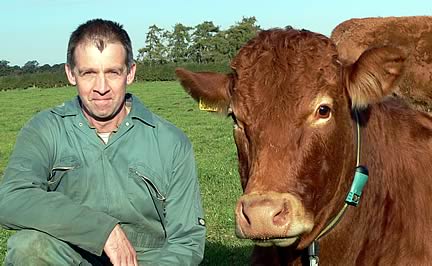
Mike with one of the” Elm House Reds” Wearing her electronic collar
Tom had previously managed suckler herds, which were primarily traditional Hereford Cross dairy animals and using his experience, they aimed to produce quality finished stock from a crossbred suckler herd. The first move was to look at improving the terminal sire they were using and with this in mind; they hired a British Blue to improve the conformation of the finished animal, without adding any calving complications either for the cows or themselves. Following some promising early results, Mike decided that using a British Blue as their terminal sire of choice was the way forward and relying heavily on the EBV information available, chose a bull which had good terminal figures, combined with an easy calving score. “It’s easy to find a selection of British Blue bulls, which have the EBV figures we were looking for in the top 10% of the breed. We finish all of our youngstock and use the Blue as a terminal sire only, milk and maternal figures are therefore irrelevant to us.” says Mike. “Our work with ASDA and ABP ensures that the beef we are producing is what the market wants and our involvement with these two organisations has allowed us to develop the suckler herd in a way which suits our system and suits the market.” he adds.
Having decided that the British Blue was the way forward to produce the kind of cattle the market wanted, Mike and Tom started to look at their cows and further develop the female side of the herd. Bearing in mind that they wanted to use a closed herd system as much as possible, to avoid health issues and to end up with a cow which was easy to manage, they looked toward the South Devon. The two had long been admirers of the breed and their mothering ability, milkiness and docility encouraged them to look closer and start a small foundation herd of pure cows from which to produce their suckler herd. The Limousin cross dairy cattle which they had started with were phased out although the Limousin is still the preferred cross onto the South Devon. “We have always been careful of the temperament of the bulls we use,” explains Mike “ and by using the likes of Ronwick Hawk, we now have a very quiet and easy to handle herd of South Devon cross Limy cows which we call “Elm House Reds. “
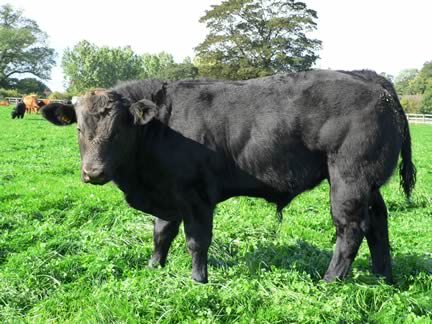
5 month old British Blue Calf out of a Red Cow
All of the cows are calved at 2 years old to either the Aberdeen Angus or the Wagyu for easy calving with some Angus cross cows being kept as replacements dependingon the breed lines of their “red mother”, but all Wagyu are taken through to finish. The aim being, to have a crossbred cow which has a good deal of hybrid vigour as the base cow to the British Blue terminal sire. “What we are doing is pretty much a traditional way of farming with crossbred cattle, while very much focusing on the muscle depth and growth EBVs of the Blue bulls we use to suit the market for finished cattle.” says Mike.
The herd is spring calving and as long as the cows are in calf and correct they remain in the herd, with some producing 10 or more calves. With depreciation being much less than it used to be on a cull cow, any which are calving out of season will be culled. The herd is also monitored by Heattime system adapted from the dairy herd, which monitors the head movement of the cows allowing Mike and Tom to pin point when each of them are coming into season, making it easier and more accurate for AI. The main unit is located in a central area in the fields and has a 400 metre range. Each cow carries a collar with a radio antenna which beams the information back to the central unit where it is collected and processed.
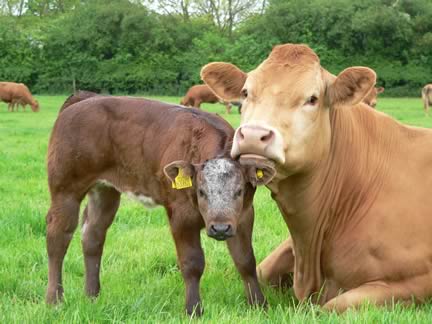
Elm House Red and British Blue Calf
The use of sexed semen for both the Red Cows and the Blues has also become common place on the farm, following an initial trial with the support ASDA and ABP and is proving to be very successful. When sexed semen was used from a British Blue two years ago for the first time, he produced 26 bull calves and one heifer calf which is a major advantage in a system such as this which produces more profit from bull beef. The herd is now on its second round of Limousin sexed female semen to produce the red cow replacements.
There is more of a consideration in using male sexed semen as it is expensive and with the increased cost of barley,(currently £220 a ton in the area) and soya rising in the past year from £260 to £420 currently, overhead costs need to be taken into account.
“While grain is becoming expensive, the bulls we have are very fast growing and will eat around 10 kilos a day towards finishing which at £200 a ton is £2 per day to feed them and we are achieving 1Kg DDWG worth £3.50 a kilo ” says Mike, “so they are still giving us a good return.
The target average for the bulls produced this year is 1kg deadweight gain per day and we’ve achieved that, which equates to 1.56kg of liveweight gain per day throughout their lives and taking birthweight off.”
While bulls are generally finished around 13 months of age, some work is being done with ABP to look at taking them on further.

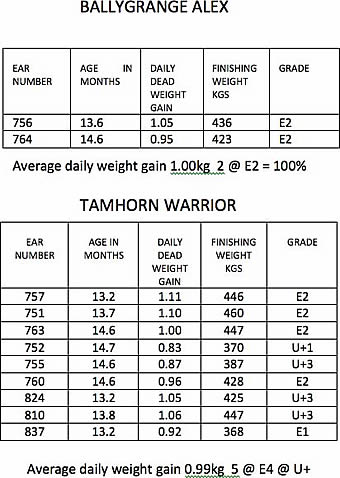
Around 6 years ago, with the British Blue bulls being used at that time, the herd was averaging 340 kilos at 355 days. Now the bulls are finishing at around 425kilos on average but Mike and Tom still think there is potential to finish the bulls at bigger weights, so long as they are not penalised by the slaughterhouse. With agreement from ABP they have recently taken one Bluegrass Cyclone bull through to 15 months to test the water. He killed at 525 kilos to an E2 specification showing a Daily Dead Weight Gain of 1.11 kilos and returning over £1800.
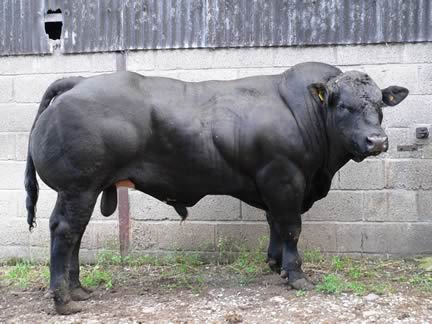
The same “experimental” 15month old bull as the picture
above
which killed at 525 kilos and E2
“In three months he had added 140 kilos” explains Tom “and as he was still growing and not laying down fat he would have moved up at least one conformation grade so we were getting paid more per kilo as well.” With this information, it is possible to try to change the supermarket view of the ideal carcass weight as the boning out percentage is much better. The work with ABP allows them to gather information on farm and disseminate this to other producers. The main issue for the supermarkets is that a carcass this size does not fit into the conventional pack size but the family have begun to make them see that there is a potential gain to both the farmer and the supermarket to at least consider the possibility of producing larger carcasses without penalty. The carcass grade is also important to the return on the cattle and with a national figure of 1.2% of cattle killed being E grade the farm is currently running at around 60% with some bulls achieving over 80% E grade with the rest killing at U- or U+. The farm aims to produce fat class 2 & 3 which gives a maximum bonus of 30p per kilo. “The beauty of using the genetics which we do, “explains Mike, “is that they can grow quickly to more kilos, without laying down fat, which is often the case when you take animals to bigger weights.”
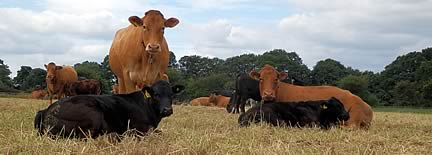
Red cows with calves at foot
Mike is particularly keen on working with suppliers as well as producers and having worked with various suppliers in the past is currently working with their grass supplier on improving the forage quality of the grass. The introduction of Red Clover as an 18% source of protein is already looking like it may be the way of finishing heifers on a forage based feed regime without concentrates.”It is important to keep questioning what you do.” says Mike. “The challenge for us is to continually improve our system and we work with both suppliers and customers to achieve this.”
As we walk through the field of Limousin cross South Devon cows with their British Blue calves at foot, few of them stand or take any notice, unless they want their head or back scratched. The basis of a simple system is working well here. Quiet easy to handle crossbred cows producing fast growing quality finishing animals for which the market will pay a premium.
A good start ensures a good finish...........just ask Usain Bolt!

